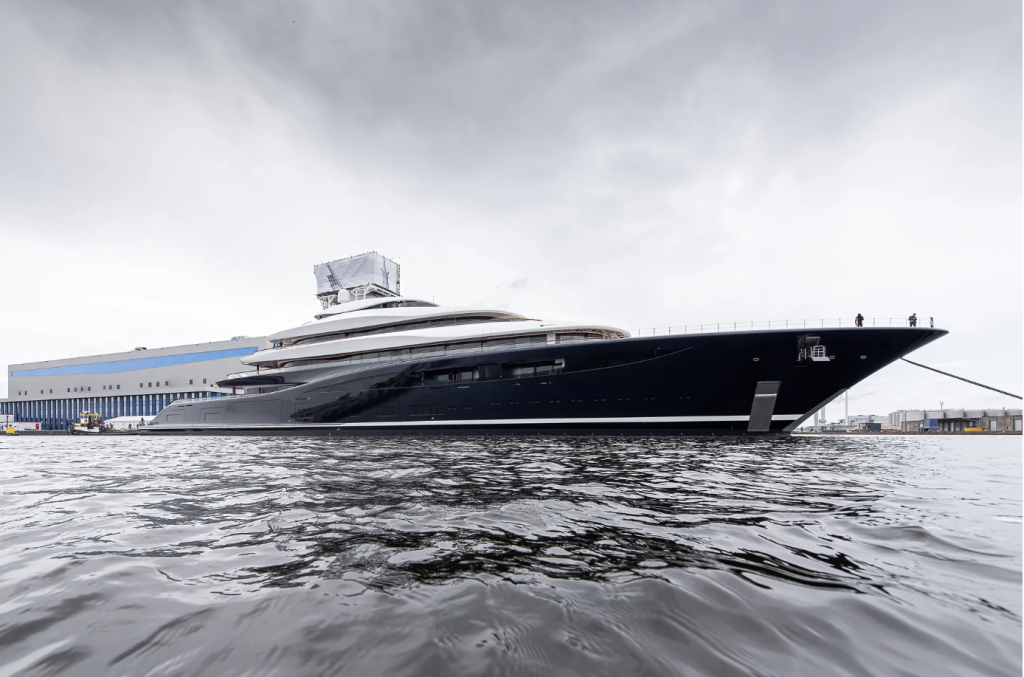Superyachts often waste engineering resources on gadgets like underwater elevators and mobile helidecks. It provides bragging rights to the owners but does nothing to advance the shipbuilding industry. Not so for Project 821. Building a multi-megawatt fuel cell system with liquid hydrogen storage in a closed environment is relevant for the entire shipbuilding industry. An engineering feat to be proud of.
Project 821 is a groundbreaking superyacht launched by Dutch shipyard Feadship on May 4, 2024. Spanning 118.8 meters, it holds the distinction of being the world’s first hydrogen fuel cell-powered superyacht, marking a significant advancement in sustainable shipbuilding since the delivery of the first LH2-fuelled ferry Hydra.

Innovative Green Technology
Project 821 employs green hydrogen to generate emission-free power for both propulsion and onboard amenities. This zero-diesel approach allows the yacht to operate silently and without emissions for up to a week while at anchor or cruising at 10 knots, significantly reducing its environmental impact.
A key challenge in the yacht’s development was the safe storage of liquid hydrogen at extremely low temperatures (-253°C). Feadship addressed this by installing a double-walled cryogenic storage tank capable of holding approximately 4 tons of hydrogen. Additionally, the fuel cells can utilize methanol, offering flexibility in fuel sources.
Design and Luxury Features
Designed by British studio RWD, Project 821 seamlessly integrates luxury with cutting-edge technology. The yacht features five decks above water and two below, with 14 deploying balconies, five shell doors, and seven significant opening platforms—the most hull openings of any Feadship to date. These elements create a harmonious indoor-outdoor experience for guests.
Liquid hydrogen installation
MAN Cryo, a division of MAN Energy Solutions, supplied the liquid-hydrogen gas-fuel supply system, marking the first installation of such technology on a superyacht. Their scope encompassed the 92 cubic meter vacuum-insulated type C tank, a tank connection space with essential process equipment like vaporizers and control valves, a bunker station for shore-to-ship bunkering, control and automation systems , a vent mast, and interconnecting hydrogen piping.
This innovative system stores hydrogen in liquid form, then evaporates and heats it to supply gaseous hydrogen to the fuel cell system, enabling the vessel’s zero-emission propulsion. MAN Cryo collaborated with Lloyd’s Register to develop a risk-assessment-based design approved for below-deck placement—a pioneering achievement in marine liquid-hydrogen projects.
Technical Specifications
- Length Overall: 118.8 meters (389’9″)
- Beam: 19 meters (62’4″)
- Draft: 5.25 meters (17’3″)
- Propulsion: 2 x 3,200 kW ABB azimuthing thrusters
- Power Supply:
- 2 x 900 kW MTU generators
- 3 x 2,500 kW MTU generators
- 16 x 185 kW PowerCell hydrogen generators (fuel cells)
- Tank: 92 m3 C-type
- Range: 6,500 nautical miles at 14 knots
- Accommodation: Up to 30 guests in 12 staterooms, with additional cabins for 44 crew members and 2 staff members
Market Availability
Shortly after its launch, Project 821 was listed for sale through yacht brokerage Edmiston. While there have been rumors linking the yacht to Microsoft co-founder Bill Gates, Feadship has not confirmed any details regarding ownership or pricing.
Leave a Reply